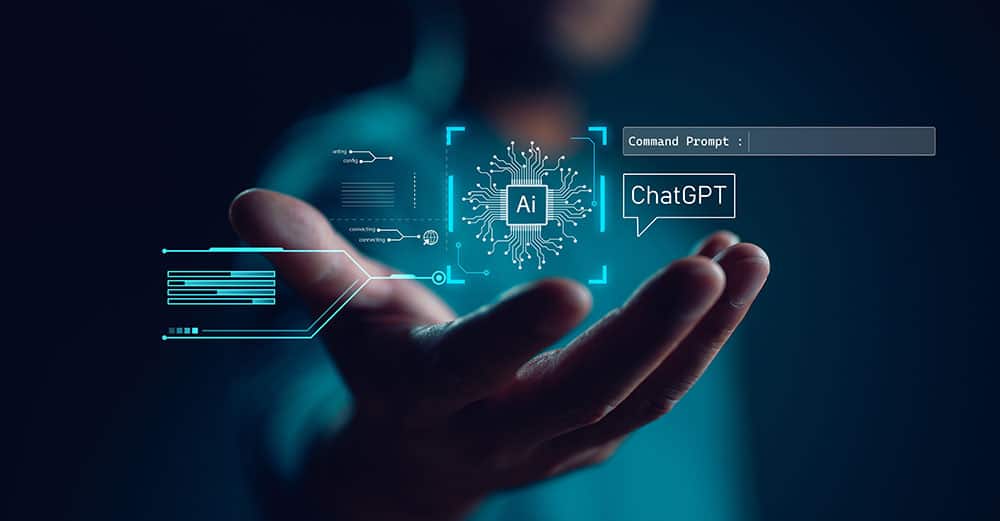
The next great leap forward is here, and it’s artificial intelligence (AI), with Open AI’s ChatGPT leading the charge. ChatGPT has already proven itself able to pass the bar, provide accurate diagnoses to patients, and even write entire applications, which made me wonder: Could ChatGPT help me make better investment decisions?
Why am I asking this obvious, but important question? Well, AI has gained traction with hedge funds and the banking industry who use it to analyze vast amounts of data to make better trading decisions and optimize their portfolios.[1]
If publicly available artificial intelligence can replicate this, smaller retail investors could possess the same edge that the whales of finance have enjoyed for many years, without requiring the ability or technical background necessary to use and understand these specialized in-house banking tools.
Heck, this is a big part of why JP Morgan has reportedly begun work on making their own ChatGPT-like tool, IndexAI — though there are scant details about who will actually have access to JP Morgan’s newly developed tool or when it will be released.[2]
So in the meantime, I’ve decided to take a look at whether ChatGPT could do the job.
Let’s dive in, starting with a brief breakdown of what ChatGPT actually is…
ChatGPT and other tools like it are Large Language Models (LLMs), which is a type of artificial intelligence model designed to generate human-like text. LLMs can be used for everything from writing assistance to creating code. These models are all trained on extremely in-depth amounts of data, which enables the AI tool or App to understand the statistical patterns of language and create convincing replies.
The most famous of these, OpenAI’s ChatGPT, has captured the public imagination because it is able to sound very human. However, it’s important to remember that these models don’t actually understand data in the same way that a human does — it simply uses its built -in algorithm to predict what a convincing response would be based on the question asked of it ‘by a human.’
To give you an idea about how this works, ChatGPT was created in three phases:
This kind of approach has been used for some time. For example a more rudimentary precursor to LLMs, Statistical Machine Translation (SMTs), has been used in machine translation since as early as 1990 and improved upon by Google in 2007 with the release of Google Translate.[3] However, OpenAI has been able to take relatively niche tools and convert them into something with mass appeal with ChatGPT.
Why? Because the tool is so versatile compared to previous iterations of LLMs, and ChatGPT has given OpenAI the perfect advertisement for what AI can do to help ordinary people potentially revolutionize their lives.
This brings us neatly to our next ultimate question: How can ChatGPT help you as an investor? Well there are a few ways that it can enhance your investing decision-making process. We’ll go through three uses, with examples, and walk you through how you can use ChatGPT to help you make possibly better investment decisions.
Before we jump into what ChatGPT can do, I’d like to explain a couple of limitations of the tool. The first thing to keep in mind is that ChatGPT is not a specialized financial AI, nor meant to replace your financial advisor right now. It does a good job despite this, but it occasionally makes errors, and if you don’t use a critical human eye, its confident tone might catch you out.
The second limitation is the September 2021 cutoff date. This means that ChatGPT does not have access to any information after that date and will not be able to interpret the market conditions surrounding a stock today — just the raw data that you give it up to this specific date mentioned..
Finally, it’s important to note that there are two versions of ChatGPT available today. There is the free 3.5 model, which is faster but a little bit more basic than the paid 4.0 version. ChatGPT 4.0 is generally considered to be more sophisticated, but you will need to pay $20 a month for the privilege.
In each of the following examples, I will explain which model I have chosen to use and why, as well as provide a link to an actual conversation, so you can check it out for yourself.
Warning: ChatGPT is not a dedicated financial analyst tool, and its results should always be verified with further research on your part or to be discussed with your financial advisor. ChatGPT should not be taken as a replacement for a licensed financial advisor.
One of the simplest ways that ChatGPT can help investors is in information aggregation. Let’s say that you have just received a lengthy financial report and quarterly report from a company you like, for example, let’s say that you wanted to understand the implication of Amazon.com’s (NASDAQ: AMZN) quarterly earnings report and what it might mean for the long-term health of the company.[4]
Now this is a big file — too big to give to ChatGPT in a single conversation due to the character limit. To get around this, I used a Google Chrome extension (found here) to upload it directly to ChatGPT 3.5. Once the file was uploaded, it provided me with the following summary:
ChatGPT then returned the following:
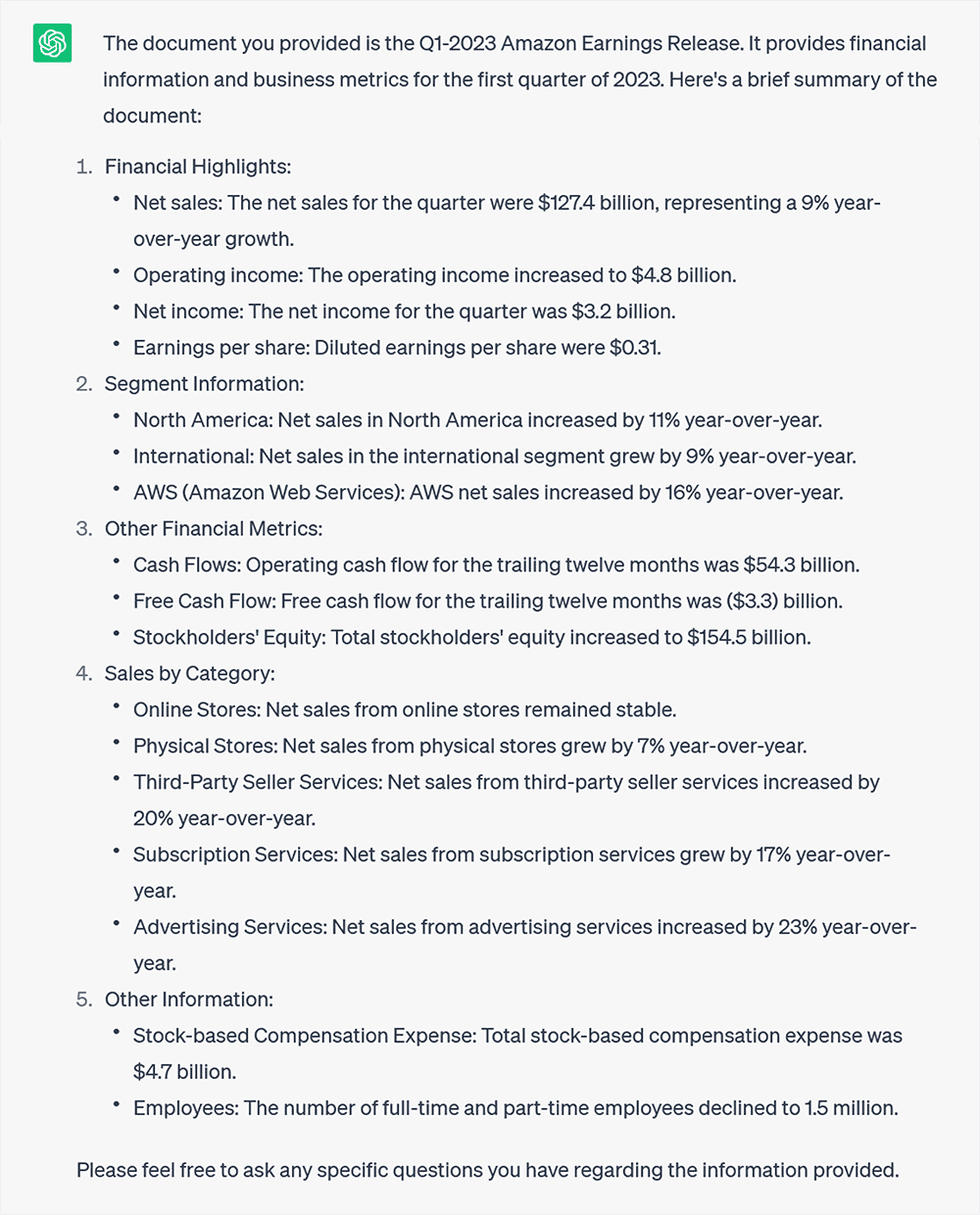
Now this in itself is useful. We’ve boiled down a fairly long, complicated document into a series of bullet points. But what if we wanted to save ourselves some trouble and ask ChatGPT for its recommendation based on that information? Well, to do that, I gave it the following prompt:

I specifically worded it this way so that ChatGPT takes on the “role” of a financial assistant, which makes it more likely to output useful information. Its response follows:
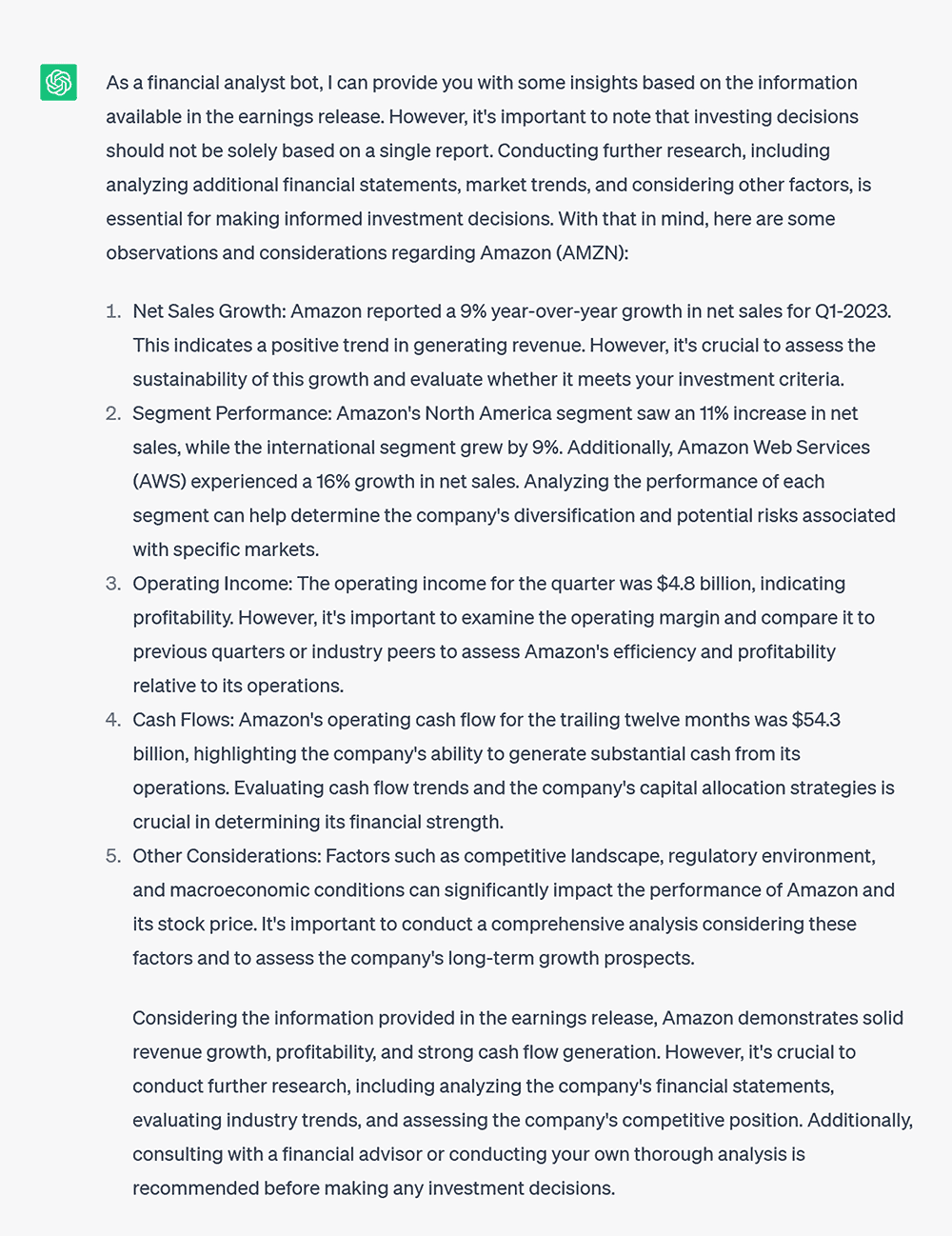
Now this is a good start. It explains the basics of the report in context but also highlights some potential areas for further consideration. In general, with my background knowledge of AMZN, this looks good and makes me want to do some further research.
You can find the chat here.[5]
We’ve decided that we’d like to know more about AMZN, so the next step is to get some recent financial data. You’ll probably have your own way of doing this. In this case, I grabbed a CSV file with historical data for the past six months for AMZN from Yahoo Finance, and then used the extension I installed earlier to upload it to ChatGPT 3.5. (In my experience, ChatGPT 3.5 tends to be a little more direct when performing calculations.)
Once again, it gave me a solid summary:
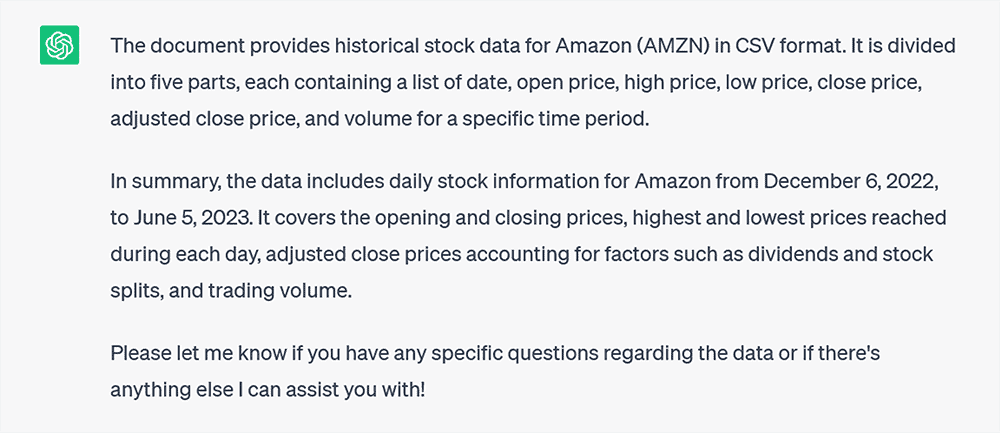
I then entered the following prompt:

The results were surprisingly accurate given that ChatGPT was not specifically trained in financial analysis. It correctly calculated Amazon’s Relative Strength Index (RSI) and provided an explanation of how to do so yourself in the future.
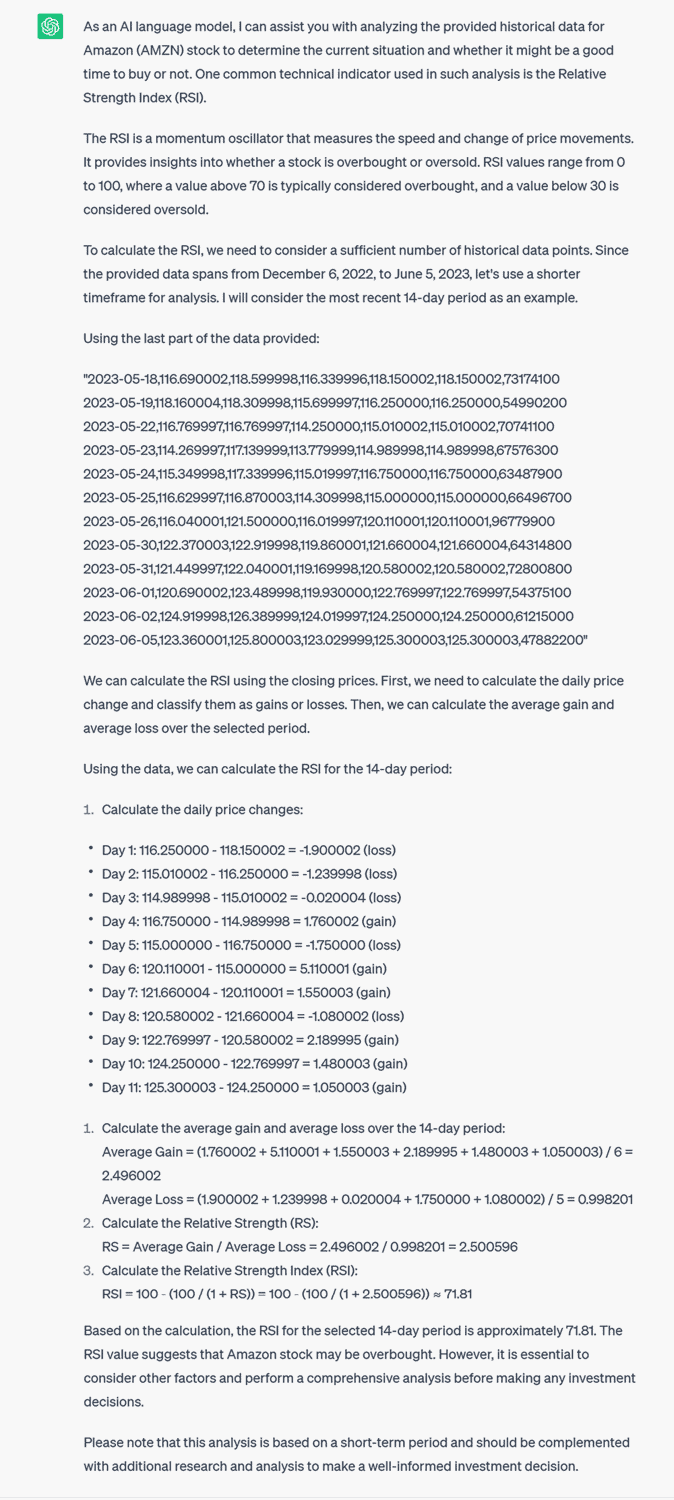
ChatGPT’s assessment that Amazon may be overbought is likely correct. If I wasn’t interested in buying AMZN stock for other reasons, I would probably take a wait and see approach before jumping in, and keep an eye on the stock’s RSI for the next few months.
You can find the whole chat here.
Now let’s look at something a little different. Let’s imagine that you want to invest in a more specialized industry, for example rare earth elements. Well let’s take a look at a company highlighted in Carl Delfield’s Rare Earth Elements article from early May on Financial News Now: Lynas Rare Earth Limited (ASX: LYC / OTC US: LYSCF).
Specifically, you understand that the value of LYC, and other similar companies, lies in the deposits they have claim to. So you decide to look at the table deposit and are confronted with this:
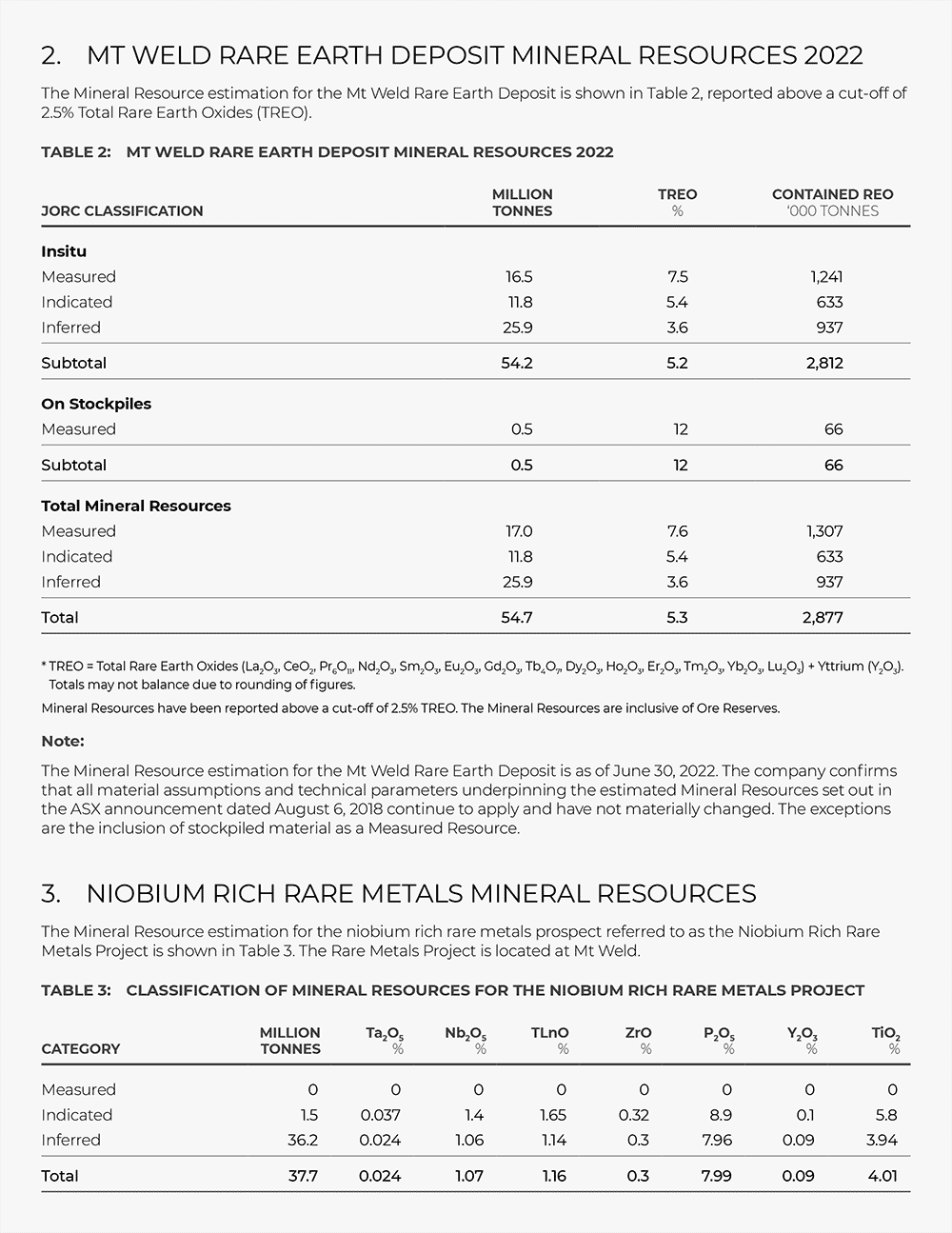
Now for a moment, let’s assume that you don’t have a background in geology (I don’t!), that the term “Rare Earth Oxides” means nothing to you, and that the large collection of elemental symbols that follow make about as much sense as Egyptian hieroglyphics. This is where ChatGPT can come to the rescue.
I used ChatGPT 4.0, as it is typically better at providing succinct explanations, and pasted the following prompt:

ChatGPT processes this for a moment, and then gives us a breakdown of all the mineral elements cited:
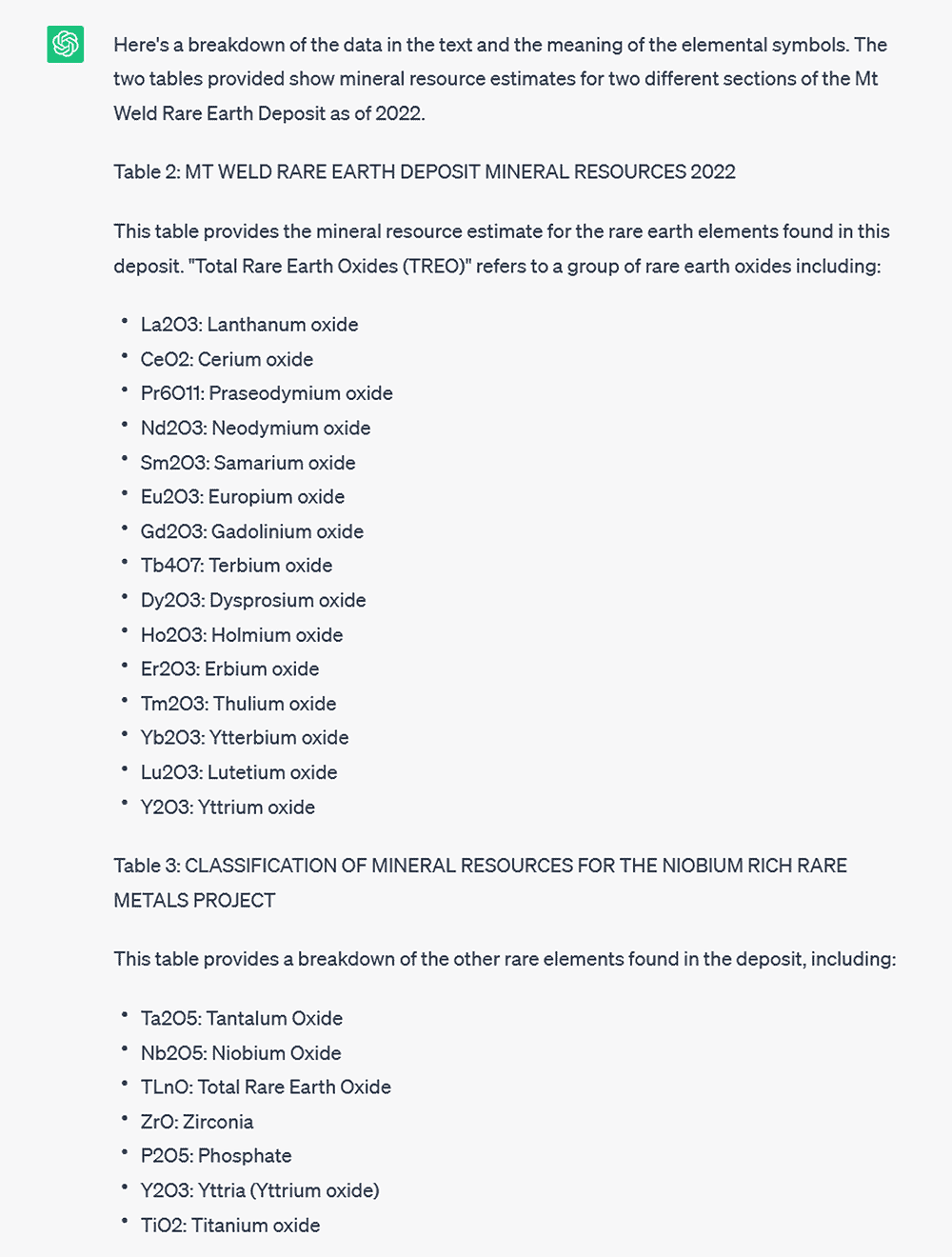
And then explains what these elements are used for:

Before finally giving me the “explain it like I’m five” explanation:

Now, what it’s not done is give me any insight into what the figures mean, so I’ll ask it to do so:

And the answer it gives me is surprisingly insightful:

This is actually very useful and puts a relatively small amount of data in context without us needing to have any in-depth experience about the rare earth elements industry. However, one phrase jumps out at me: “Considering that Mt Weld is one of the highest-grade rare earth deposits in the world…”
Now, we (hypothetically) don’t know much about REEs, but we do know that statements like this require some scrutiny, so let’s ask ChatGPT how it came to that conclusion:
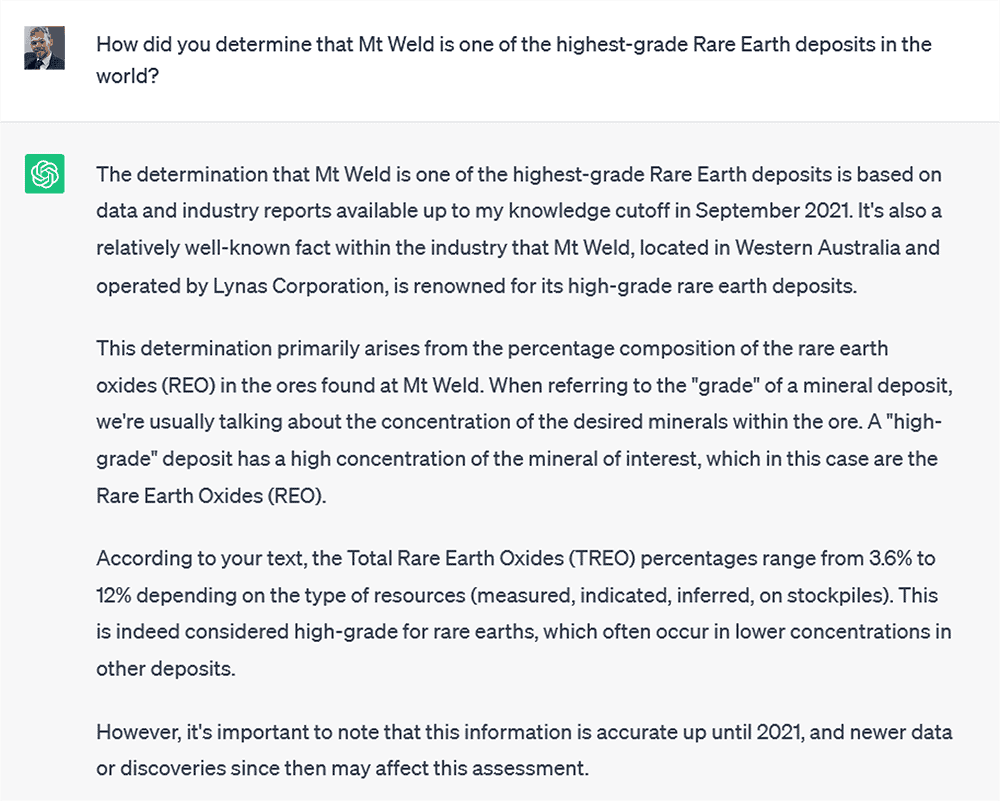
Alright, that’s convincing, and gives us some pretty useful context, but let’s do a bit more due diligence and check whether Google agrees — and it does. I’ve found three separate sources that corroborate what ChatGPT is saying.[6] [7] [8]
The example I’ve given above is fairly niche, and you should always exercise critical thinking when using ChatGPT. And, if you’re a newcomer, ChatGPT can help to turn days of research into a matter of an hour or two and give you a solid basis for whether the company you’re looking at is really onto something or not.
Once again, you can find the chat here.

As you can see from these tests, ChatGPT is a powerful tool to aid your decision-making, but it can’t replace your own critical thinking. When I use it, and I do use it regularly, I think of it as having an assistant with a wealth of knowledge that I can tap into… Ultimately streamlining my research and analysis process.
I think that ChatGPT 4.0 in particular is useful as a learning tool, especially for new investors or newcomers to a particular industry. It is good at taking relatively complicated information and making it understandable.
Important Tip: When dealing with ChatGPT, it is important to carefully craft your prompt. Asking for help making a decision tends to be more effective than asking it for an outright recommendation and using simple direct language is most effective.
With that said, there are some very real limitations, which I’ve already hinted at. You may have noticed that the process is very manual, as there is currently no way to easily integrate ChatGPT into your spreadsheets specifically for financial analysis, and the data needs to be pasted into the app. This also means you can’t interpret large datasets, as there is an input limit of around 4,000 characters.[9]
Additionally, I’ve noticed that using ChatGPT has a tendency to give lower quality responses as the length of a conversation grows. Also, the increased complexity of the conversation makes it harder for the algorithm to identify what information should come next and impairs accuracy. In general, it is most useful if you keep prompts precise and to the point, as you would when requesting information from a human.
So this probably has you thinking about how you can get a piece of the AI action. Sadly, OpenAI (Chat-GTP) isn’t a publicly traded company, so unless you’ve got some pretty good connections, you won’t be able to invest in them anytime soon.
But… there are other options that are worth considering, and as a bonus, I’ll be including ChatGPT’s take on some of these stocks alongside my own analysis.
In each case, I’ve provided ChatGPT with historical data from Yahoo Finance, and asked it to use that as the basis for its analysis.
If you want a more in-depth dive into AI stocks, please check out this piece by my colleague MF Williams.

This isn’t exactly a unique take, but for my money, NVIDIA Corporation (NASDAQ: NVDA) remains one of the safest bets for artificial intelligence today. The company’s strong take on AI briefly helped it achieve a valuation of $1 trillion.[10]
The secret? NVIDIA’s latest chips are uniquely well suited to powering artificial intelligence neural networks and were the secret sauce that helped to make ChatGPT’s Large Language Models (LLMs) itself possible.[11]
However, the chipmaker is riding at a high, so let’s see what ChatGPT says about whether now is a good moment to jump in or not:
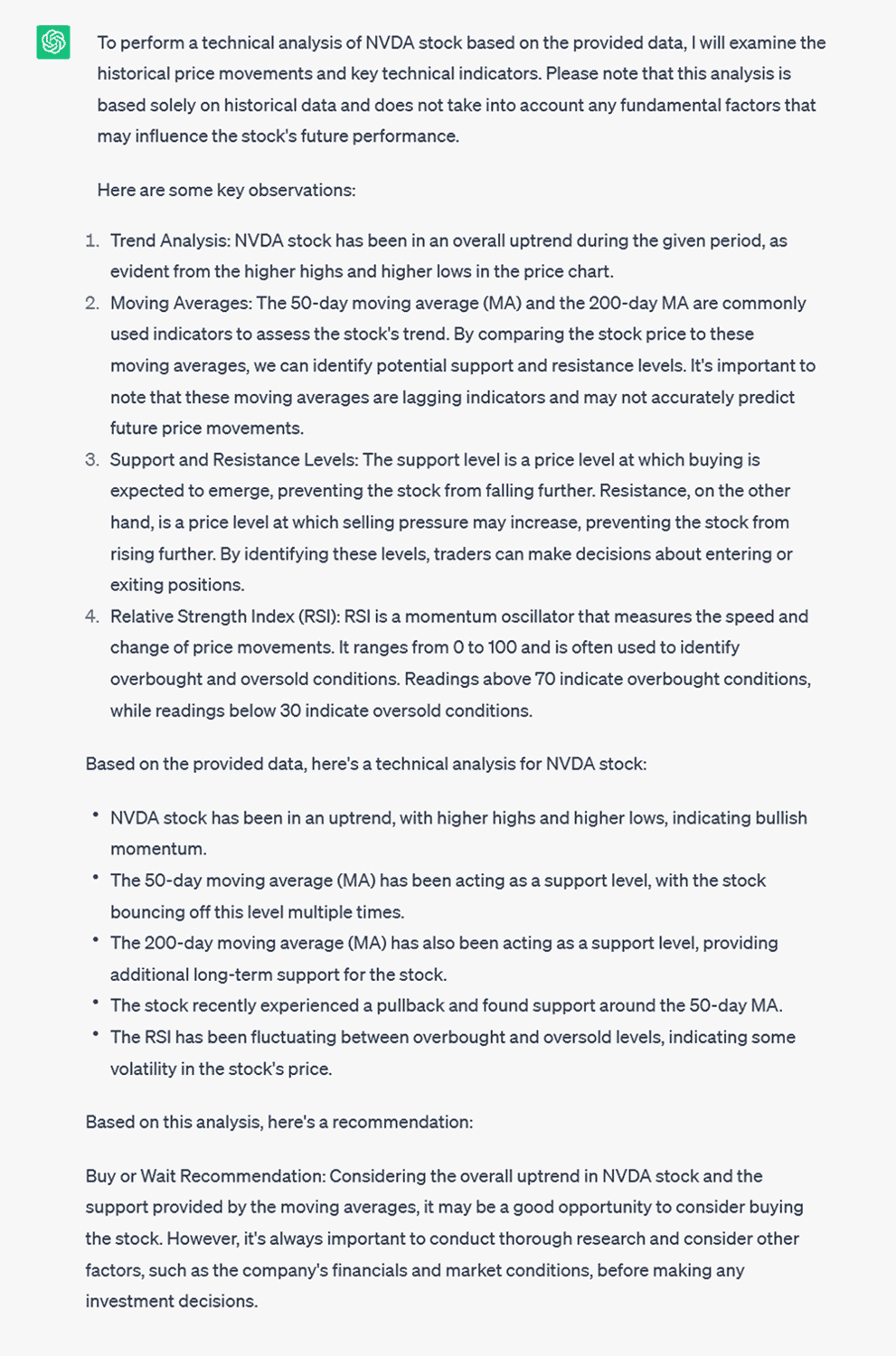
On its own, this analysis isn’t very helpful, and it is important to note that the data used is just historical trading data pulled from Yahoo Finance. However I believe that the AI boom is far from over, so NVIDIA stock will have some staying power. It is a relatively safe option with limited growth potential.
One note against NVIDIA though. Many analysts believe that the company is overvalued and ahead of the curve.[12] So there is some risk of a sudden price drop in the future, although I believe that NVIDIA remains a solid buy for anyone with a long investment horizon and would be surprised if the chipmaker saw any long-term decline.
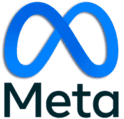
Meta Platforms, Inc. (NASDAQ: META) is an interesting one. The company suffered some serious setbacks after a fairly disastrous launch of its Metaverse, but the stock has been slowly but surely climbing back to recovery over the past few months.
More recently, Meta has pivoted to focus on artificial intelligence — with its new AI approach reportedly cutting memory consumption by 56% and GPU use by 84%.[13]
Before we dive into my analysis, let’s see what ChatGPT has to say. Once again, we’re using historical data pulled from Yahoo Finance to make this determination:
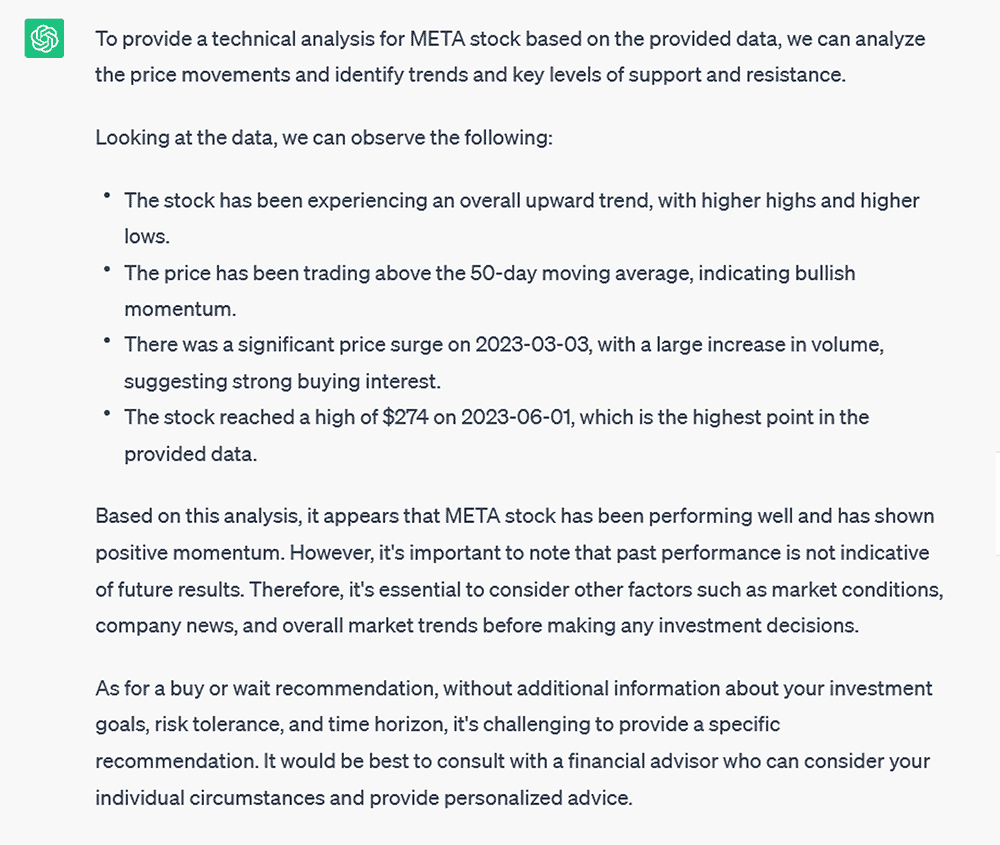
Alright, so less useful than before, but we can see that there is strong buying interest in META. By my own calculations we have an RSI of 82, which puts us into overbought territory, so a retraction is likely. This, coupled with the recent release of META’s latest headset, makes me think that waiting for a dip before jumping in would be a wise move unless you have a particularly long investment horizon.

Another tech giant, but with good reason. Alphabet Inc. (NASDAQ: GOOG) started off slowly, experiencing a major stumble when Bard was first released. However, they now appear to be finally finding their footing.[14]
The company, seemingly spooked by OpenAI’s agreement with Microsoft, has rushed to further develop its AI capabilities, recently merging its two AI groups Google Brain and MindAI.[15]
With that background, let’s see what ChatGPT has to say, and again, we’ll be pulling our data from Yahoo Finance for consistency:
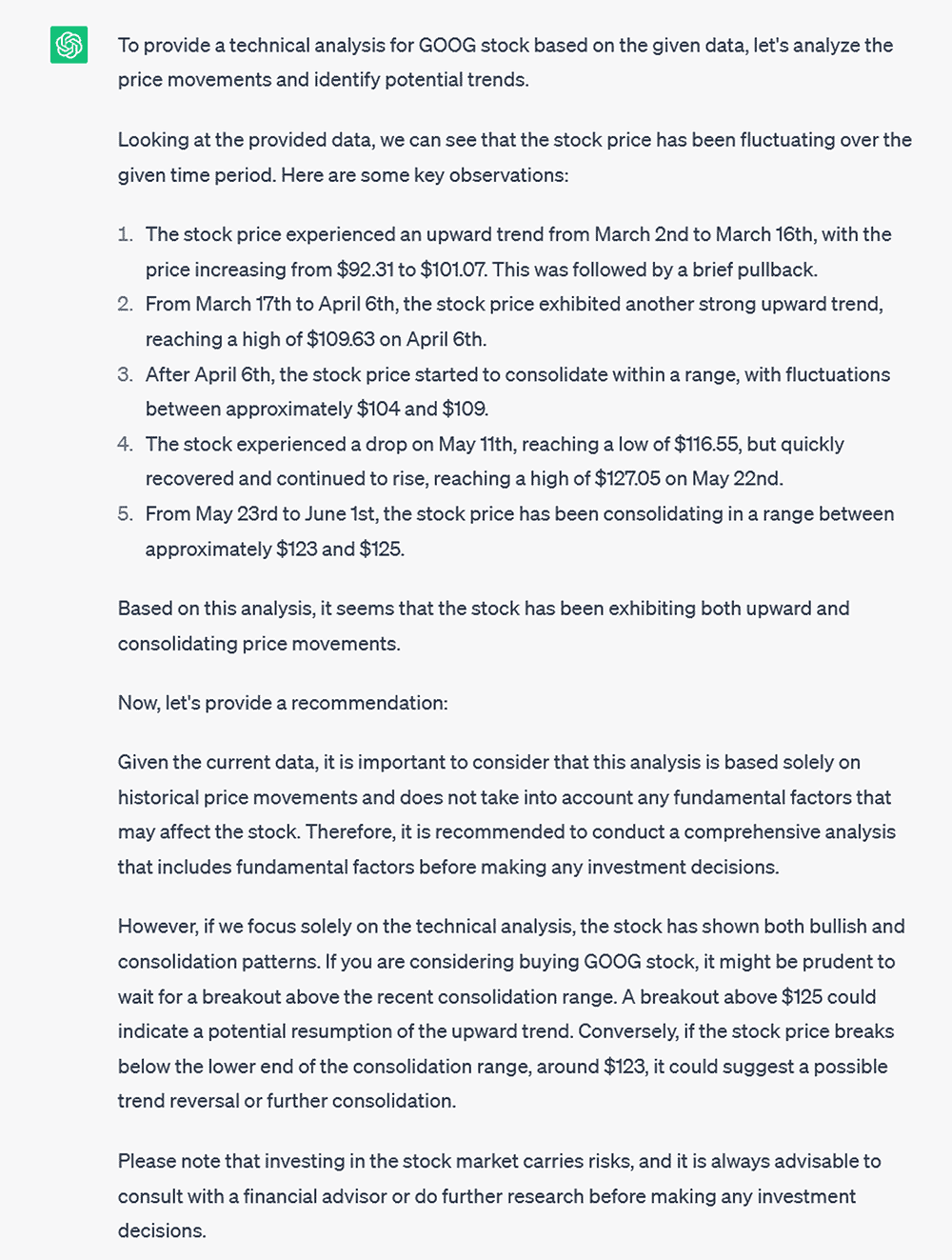
A fairly noncommittal answer, but that’s fine. There’s still useful info here. Given that GOOG remains in the middle of the pack for tech stocks and that its RSI is trending down to around 67, I’d say that now is a good moment to jump in, or at least set a buy order a little below where the stock price currently stands.
We have covered a lot here, but I believe we can draw an important lesson about AI. Although ChatGPT is still relatively new and unspecialized, it has the capacity to make it significantly easier for retail investors to break down new opportunities, and more importantly, to understand the specifics about what they’re investing in without specialized knowledge.
This is where the true power of AI tools lies — in democratizing access to tools that were previously only available to seasoned financial professionals working in the brokerage sector. There are significant opportunities for investors, both in terms of actual investing and in the way that these tools will continue to grow and specialize, hopefully making it easier for all of us to build a secure financial future for our families.
If you decide to use these tools, and I believe you should at the very least play with it… just remember that there will never be any supplement for your own or your financial advisor’s critical thinking skills. And no matter what ChatGPT tells you, a bit of your own research will go a long way in maximizing your investment returns. However, this is a very nice tool to include within your portfolio building arsenal.

Saul Bowden, Contributor
for Investors News Service
P.S. To discover more opportunities in the hottest sectors in North America, sign up now to the Financial News Now newsletter to get the latest updates and investment ideas directly in your inbox!
DISCLAIMER: Investing in any securities or cryptocurrencies is highly speculative. Please be sure to always do your own due diligence before making any investment decisions. Read our full disclaimer here.
[1] https://www.bnymellon.com/us/en/insights/all-insights/artificial-intelligence-sweeps-hedge-funds.html
[2] https://www.cnbc.com/2023/05/25/jpmorgan-develops-ai-investment-advisor.html
[3]https://www.freecodecamp.org/news/a-history-of-machine-translation-from-the-cold-war-to-deep-learning-f1d335ce8b5/
[4] https://ir.aboutamazon.com/news-release/news-release-details/2023/Amazon.com-Announces-First-Quarter-Results/
[5] https://chat.openai.com/share/bec3e9b1-be49-4b5b-a87e-0af720b49129
[6] https://www.nsenergybusiness.com/projects/mt-weld-rare-earths-mine/
[7] https://www.nsenergybusiness.com/projects/mt-weld-rare-earths-mine/
[8] https://en.wikipedia.org/wiki/Mount_Weld_mine
[9] https://www.androidauthority.com/chatgpt-character-limit-3292997/
[10] https://www.thetimes.co.uk/article/nvidia-joins-1trn-club-as-investors-buy-into-story-of-ai-nrkhzhrg7
[11] https://medium.com/@ArunPrakashAsokan/nvidias-ai-revolution-story-behind-how-it-became-a-trillion-dollar-company-620e7235fdc
[12] https://finance.yahoo.com/news/cathie-wood-calls-nvidia-stock-overpriced-after-missing-2023-rally-134528552.html
[13] https://finance.yahoo.com/quote/META/history?p=META
[14] https://www.reuters.com/technology/google-ai-chatbot-bard-offers-inaccurate-information-company-ad-2023-02-08/
[15] https://www.cnbc.com/2023/04/20/alphabet-merges-ai-focused-groups-deepmind-and-google-research.html